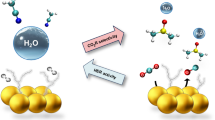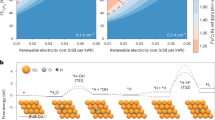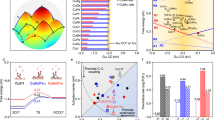Abstract
Electrochemical reduction of carbon monoxide is a promising carbonate-free approach to produce ethylene using renewable electricity. However, the performance of this process suffers from low selectivity and energy efficiency. A priority has been to weaken water dissociation with the aim of inhibiting the competing hydrogen evolution reaction but when this path was examined by replacing H2O with D2O, a further-reduced selectivity toward ethylene was observed. Here we examine approaches to promote water adsorption and to decrease the energy barrier to the ensuing water dissociation step, which could promote C–O cleavage in *CHCOH hydrogenation to *CCH. We modified a copper catalyst with the strong electron acceptor 7,7,8,8-tetracyanoquinodimethane, which made the catalyst surface electron deficient. The observed ethylene Faradaic efficiency was 75%, 1.3 times greater than that of unmodified copper control catalysts. A full-cell energy efficiency of 32% was achieved for a total projected energy cost of 154 GJ t−1 in ethylene electrosynthesis in a membrane electrode assembly.

This is a preview of subscription content, access via your institution
Access options
Subscribe to this journal
Receive 12 digital issues and online access to articles
118,99 € per year
only 9,92 € per issue
Buy this article
- Purchase on SpringerLink
- Instant access to full article PDF
Prices may be subject to local taxes which are calculated during checkout




Similar content being viewed by others
Data availability
All necessary data supporting the findings of this study are available in the Article and its Supplementary Information.
References
Yang, B. et al. Accelerating CO2 electroreduction to multicarbon products via synergistic electric-thermal field on copper nanoneedles. J. Am. Chem. Soc. 144, 3039–3049 (2022).
Liu, W. et al. Electrochemical CO2 reduction to ethylene by ultrathin CuO nanoplate arrays. Nat. Commun. 13, 1877 (2022).
Xia, R., Overa, S. & Jiao, F. Emerging electrochemical processes to decarbonize the chemical industry. JACS Au 2, 1054–1070 (2022).
Chen, X. et al. Electrochemical CO2-to-ethylene conversion on polyamine-incorporated Cu electrodes. Nat. Catal. 4, 20–27 (2020).
Li, P. et al. p–d orbital hybridization induced by p-block metal-doped Cu promotes the formation of C2+ products in ampere-level CO2 electroreduction. J. Am. Chem. Soc. 145, 4675–4682 (2023).
Gu, J. et al. Modulating electric field distribution by alkali cations for CO2 electroreduction in strongly acidic medium. Nat. Catal. 5, 268–276 (2022).
Zhao, Y. et al. Conversion of CO2 to multicarbon products in strong acid by controlling the catalyst microenvironment. Nat. Synth. 2, 403–412 (2023).
She, X. et al. Pure-water-fed, electrocatalytic CO2 reduction to ethylene beyond 1,000 h stability at 10 A. Nat. Energy 9, 81–91 (2024).
Rabinowitz, J. A. & Kanan, M. W. The future of low-temperature carbon dioxide electrolysis depends on solving one basic problem. Nat. Commun. 11, 5231 (2020).
Jouny, M., Hutchings, G. S. & Jiao, F. Carbon monoxide electroreduction as an emerging platform for carbon utilization. Nat. Catal. 2, 1062–1070 (2019).
Zhu, P. et al. Direct and continuous generation of pure acetic acid solutions via electrocatalytic carbon monoxide reduction. Proc. Natl Acad. Sci. USA 118, e2010868118 (2021).
Ozden, A. et al. Cascade CO2 electroreduction enables efficient carbonate-free production of ethylene. Joule 5, 706–719 (2021).
Wei, P. et al. Coverage-driven selectivity switch from ethylene to acetate in high-rate CO2/CO electrolysis. Nat. Nanotechnol. 18, 299–306 (2023).
Zhang, J. et al. Steering CO2 electroreduction pathway toward ethanol via surface-bounded hydroxyl species-induced noncovalent interaction. Proc. Natl Acad. Sci. USA 120, e2218987120 (2023).
Zhu, H.-L. et al. A porous π–π stacking framework with dicopper(I) sites and adjacent proton relays for electroreduction of CO2 to C2+ products. J. Am. Chem. Soc. 144, 13319–13326 (2022).
Goyal, A. & Koper, M. T. M. The interrelated effect of cations and electrolyte pH on the hydrogen evolution reaction on gold electrodes in alkaline media. Angew. Chem. Int. Ed. 60, 13452–13462 (2021).
Li, P. et al. Hydrogen bond network connectivity in the electric double layer dominates the kinetic pH effect in hydrogen electrocatalysis on Pt. Nat. Catal. 5, 900–911 (2022).
Liu, E. et al. Unifying the hydrogen evolution and oxidation reactions kinetics in base by identifying the catalytic roles of hydroxyl-water-cation adducts. J. Am. Chem. Soc. 141, 3232–3239 (2019).
Kumar, S., Hoshino, M., Kerkeni, B., García, G. & Limão-Vieira, P. Isotope effect in D2O negative ion formation in electron transfer experiments: DO–D bond dissociation energy. J. Phys. Chem. Lett. 14, 5362–5369 (2023).
Andersson, K., Nikitin, A., Pettersson, L. G. M., Nilsson, A. & Ogasawara, H. Water dissociation on Ru(001): an activated process. Phys. Rev. Lett. 93, 196101 (2004).
Li, J. et al. Electrokinetic and in situ spectroscopic investigations of CO electrochemical reduction on copper. Nat. Commun. 12, 3264 (2021).
Liang, Y. et al. Stabilizing copper sites in coordination polymers toward efficient electrochemical C–C coupling. Nat. Commun. 14, 474 (2023).
Shao, F. et al. Surface water as an initial proton source for the electrochemical CO reduction reaction on copper surfaces. Angew. Chem. Int. Ed. 62, e202214210 (2023).
Li, Y. et al. Interstitial boron-triggered electron-deficient Os aerogels for enhanced pH-universal hydrogen evolution. Nat. Commun. 13, 1143 (2022).
Strmcnik, D. et al. Improving the hydrogen oxidation reaction rate by promotion of hydroxyl adsorption. Nat. Chem. 5, 300–306 (2013).
Dong, Y. et al. Efficient water dissociation on confined ultrafine Pt via pyridinic N-enhanced heavy d–π interaction. Chem. Mater. 34, 8271–8279 (2022).
Xie, Y. et al. Boosting water dissociation kinetics on Pt–Ni nanowires by N-induced orbital tuning. Adv. Mater. 31, 1807780 (2019).
Blowey, P. J. et al. Alkali doping leads to charge-transfer salt formation in a two-dimensional metal–organic framework. ACS Nano 14, 7475–7483 (2020).
Otero, R., Miranda, R. & Gallego, J. M. A comparative computational study of the adsorption of TCNQ and F4-TCNQ on the coinage metal surfaces. ACS Omega 4, 16906–16915 (2019).
Tseng, T.-C. et al. Charge-transfer-induced structural rearrangements at both sides of organic/metal interfaces. Nat. Chem. 2, 374–379 (2010).
Mahajan, M., Bhargava, S. K. & O’Mullane, A. P. Reusable surface confined semi-conducting metal-TCNQ and metal-TCNQF4 catalysts for electron transfer reactions. RSC Adv. 3, 4440–4446 (2013).
Wang, N. et al. Boride-derived oxygen-evolution catalysts. Nat. Commun. 12, 6089 (2021).
Overa, S. et al. Enhancing acetate selectivity by coupling anodic oxidation to carbon monoxide electroreduction. Nat. Catal. 5, 738–745 (2022).
Ding, P. et al. Elucidating the roles of Nafion/solvent formulations in copper-catalyzed CO2 electrolysis. ACS Catal. 13, 5336–5347 (2023).
Gunathunge, C. M., Li, J., Li, X. & Waegele, M. M. Surface-adsorbed CO as an infrared probe of electrocatalytic interfaces. ACS Catal. 10, 11700–11711 (2020).
Zhang, T., Yuan, B., Wang, W., He, J. & Xiang, X. Tailoring *H intermediate coverage on the CuAl2O4/CuO catalyst for enhanced electrocatalytic CO2 reduction to ethanol. Angew. Chem. Int. Ed. 135, e202302096 (2023).
An, H. et al. Sub-second time-resolved surface-enhanced Raman spectroscopy reveals dynamic CO intermediates during electrochemical CO2 reduction on copper. Angew. Chem. Int. Ed. 60, 16576–16584 (2021).
Patra, K. K. et al. Operando spectroscopic investigation of a boron-doped CuO catalyst and its role in selective electrochemical C–C coupling. ACS Appl. Energy Mater. 3, 11343–11349 (2020).
Xiao, H., Cheng, T. & Goddard, W. A. Atomistic mechanisms underlying selectivities in C1 and C2 products from electrochemical reduction of CO on Cu(111). J. Am. Chem. Soc. 139, 130–136 (2017).
Li, F. et al. Cooperative CO2-to-ethanol conversion via enriched intermediates at molecule-metal catalyst interfaces. Nat. Catal. 3, 75–82 (2020).
Li, Z. et al. Room-temperature high-performance H2S sensor based on porous CuO nanosheets prepared by hydrothermal method. ACS Appl. Mater. Interfaces 8, 20962–20968 (2016).
Wang, X. et al. Efficient electrosynthesis of n-propanol from carbon monoxide using a Ag–Ru–Cu catalyst. Nat. Energy 7, 170–176 (2022).
Li, F. et al. Molecular tuning of CO2-to-ethylene conversion. Nature 577, 509–513 (2020).
Ravel, B. & Newville, M. ATHENA, ARTEMIS, HEPHAESTUS: data analysis for X-ray absorption spectroscopy using IFEFFIT. J. Synchrotron Rad. 12, 537–541 (2005).
Kresse, G. & Furthmüller, J. Efficient iterative schemes for ab initio total-energy calculations using a plane-wave basis set. Phys. Rev. B 54, 11169–11186 (1996).
Payne, M. C., Teter, M. P., Allan, D. C., Arias, T. A. & Joannopoulos, J. D. Iterative minimization techniques for ab initio total-energy calculations: molecular dynamics and conjugate gradients. Rev. Mod. Phys. 64, 1045–1097 (1992).
Blöchl, P. E. Projector augmented-wave method. Phys. Rev. B 50, 17953–17979 (1994).
Kresse, G. & Joubert, D. From ultrasoft pseudopotentials to the projector augmented-wave method. Phys. Rev. B 59, 1758–1775 (1999).
Monkhorst, H. J. & Pack, J. D. Special points for Brillouin-zone integrations. Phys. Rev. B 13, 5188–5192 (1976).
Grimme, S., Antony, J., Ehrlich, S. & Krieg, H. A consistent and accurate ab initio parametrization of density functional dispersion correction (DFT-D) for the 94 elements H–Pu. J. Chem. Phys. 132, 154104 (2010).
Nørskov, J. K. et al. Origin of the overpotential for oxygen reduction at a fuel-cell cathode. J. Phys. Chem. B 108, 17886–17892 (2004).
Henkelman, G., Uberuaga, B. P. & Jónsson, H. A climbing image nudged elastic band method for finding saddle points and minimum energy paths. J. Chem. Phys. 113, 9901–9904 (2000).
Bader, R. F. W. A quantum theory of molecular structure and its applications. Chem. Rev. 91, 893–928 (1991).
Tang, W., Sanville, E. & Henkelman, G. A grid-based Bader analysis algorithm without lattice bias. J. Phys. Condens. Matter 21, 084204 (2009).
Hoover, W. G. Canonical dynamics: equilibrium phase-space distributions. Phys. Rev. A 31, 1695–1697 (1985).
Nosé, S. Constant temperature molecular dynamics methods. Prog. Theor. Phys. Supp. 103, 1–46 (1991).
Acknowledgements
The authors acknowledge funding from the Natural Sciences and Engineering Research Council of Canada (NSERC) and TotalEnergies SE (TotalEnergies Research & Technology Feluy (an affiliate of TotalEnergies SE, France)). J.Z. acknowledges support from NSFC (22250007, 22361162655). J.Z. and Fengwang Li are grateful to the International Partnership Program of the Chinese Academy of Sciences (123GJHZ2022101GC). W.N. acknowledges financial support from the Swiss National Science Foundation (SNSF) for a Postdoctoral Mobility Fellowship (202906).
Author information
Authors and Affiliations
Contributions
E.H.S, D.S., J.Z. and Fengwang Li supervised the project. Y. Liang synthesized the catalysts and performed all the electrochemical experiments. Feng Li carried out the DFT calculations, ab initio molecular dynamics simulation, and multiphysics simulation. P.O. and X.-Y.L. participated in the computational data analysis. R.K.M performed the cascade system modelling and calculated the energy cost. S.H. performed transmission electron microscopy, high-resolution transmission electron microscopy and energy-dispersive X-ray spectroscopy mapping experiments. W.N. and S.P. assisted in electrochemical and operando Raman experiments. S.Z. conducted the operando XAS experiments. Y. Liu carried out the XPS experiments. Y.B. contributed to the CORR isotope experiments and data analysis. H.W. assisted in the X-ray diffraction experiments. N.W. provided the NiFe-B anode catalysts. Y. Liang, E.H.S., Fengwang Li and D.S. co-wrote and edited the manuscript. All authors discussed the results and assisted during the manuscript preparation.
Corresponding authors
Ethics declarations
Competing interests
The authors declare no competing interests.
Peer review
Peer review information
Nature Synthesis thanks Yongji Gong and the other, anonymous, reviewer(s) for their contribution to the peer review of this work. Primary Handling Editor: Alexandra Groves, in collaboration with the Nature Synthesis team.
Additional information
Publisher’s note Springer Nature remains neutral with regard to jurisdictional claims in published maps and institutional affiliations.
Supplementary information
Supplementary Information
Supplementary Figs. 1–40, Notes 1–4 and Tables 1–5.
Source data
Source Data Fig. 1
Source Data for Fig. 1.
Source Data Fig. 2
Source Data for Fig. 2.
Source Data Fig. 3
Source Data for Fig. 3.
Source Data Fig. 4
Source Data for Fig. 4.
Rights and permissions
Springer Nature or its licensor (e.g. a society or other partner) holds exclusive rights to this article under a publishing agreement with the author(s) or other rightsholder(s); author self-archiving of the accepted manuscript version of this article is solely governed by the terms of such publishing agreement and applicable law.
About this article
Cite this article
Liang, Y., Li, F., Miao, R.K. et al. Efficient ethylene electrosynthesis through C–O cleavage promoted by water dissociation. Nat. Synth 3, 1104–1112 (2024). https://doi.org/10.1038/s44160-024-00568-8
Received:
Accepted:
Published:
Issue Date:
DOI: https://doi.org/10.1038/s44160-024-00568-8
This article is cited by
-
Electrocatalytic CO2 hydrogenation to C2+ alcohols catalysed by Pr–Cu oxide heterointerfaces
Nature Synthesis (2025)
-
Advances in ferroelectric and piezoelectric photocatalysts with oxygen vacancy
Carbon Letters (2025)
-
Efficient ethylene electrosynthesis by accelerating water dissociation
Nature Synthesis (2024)



